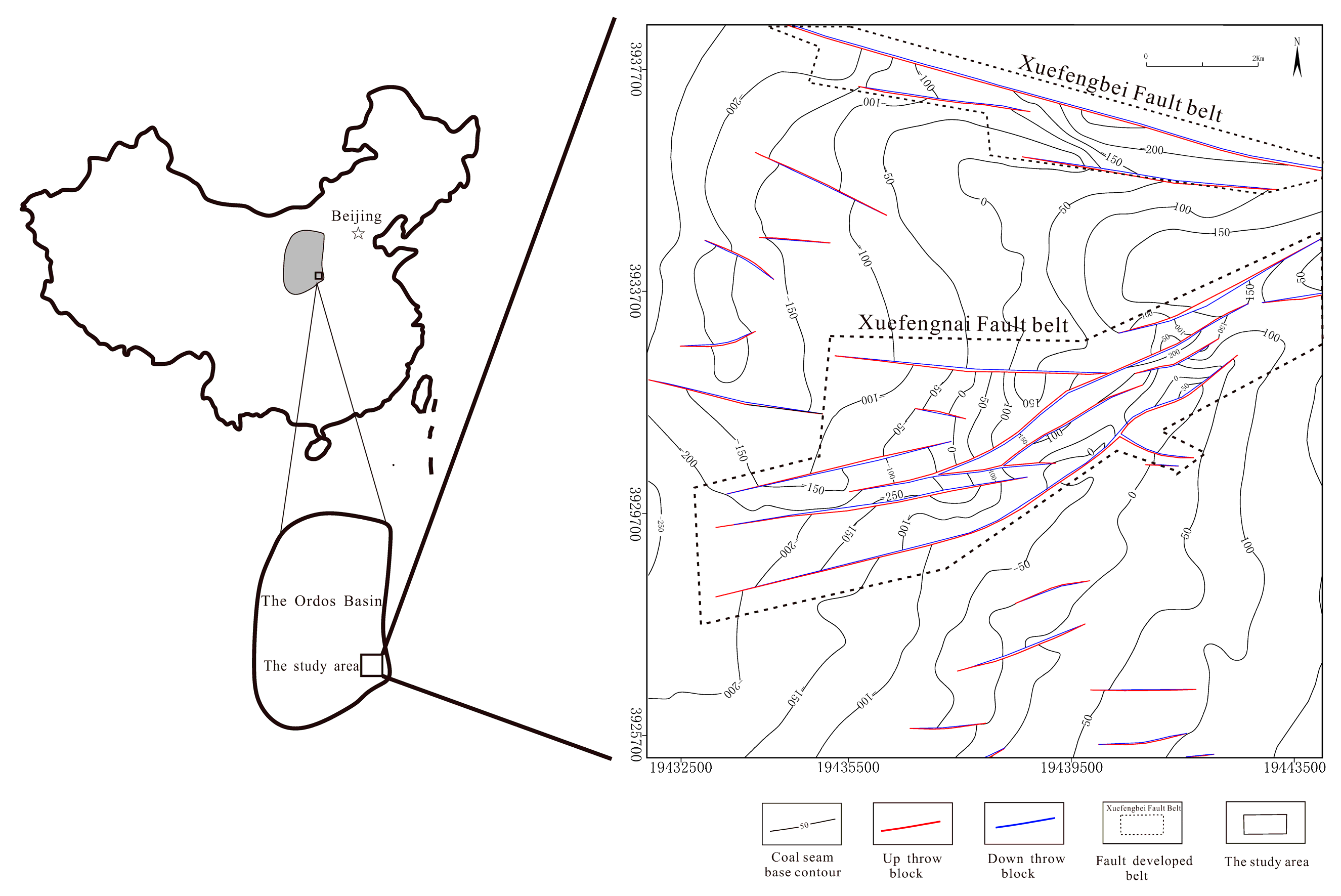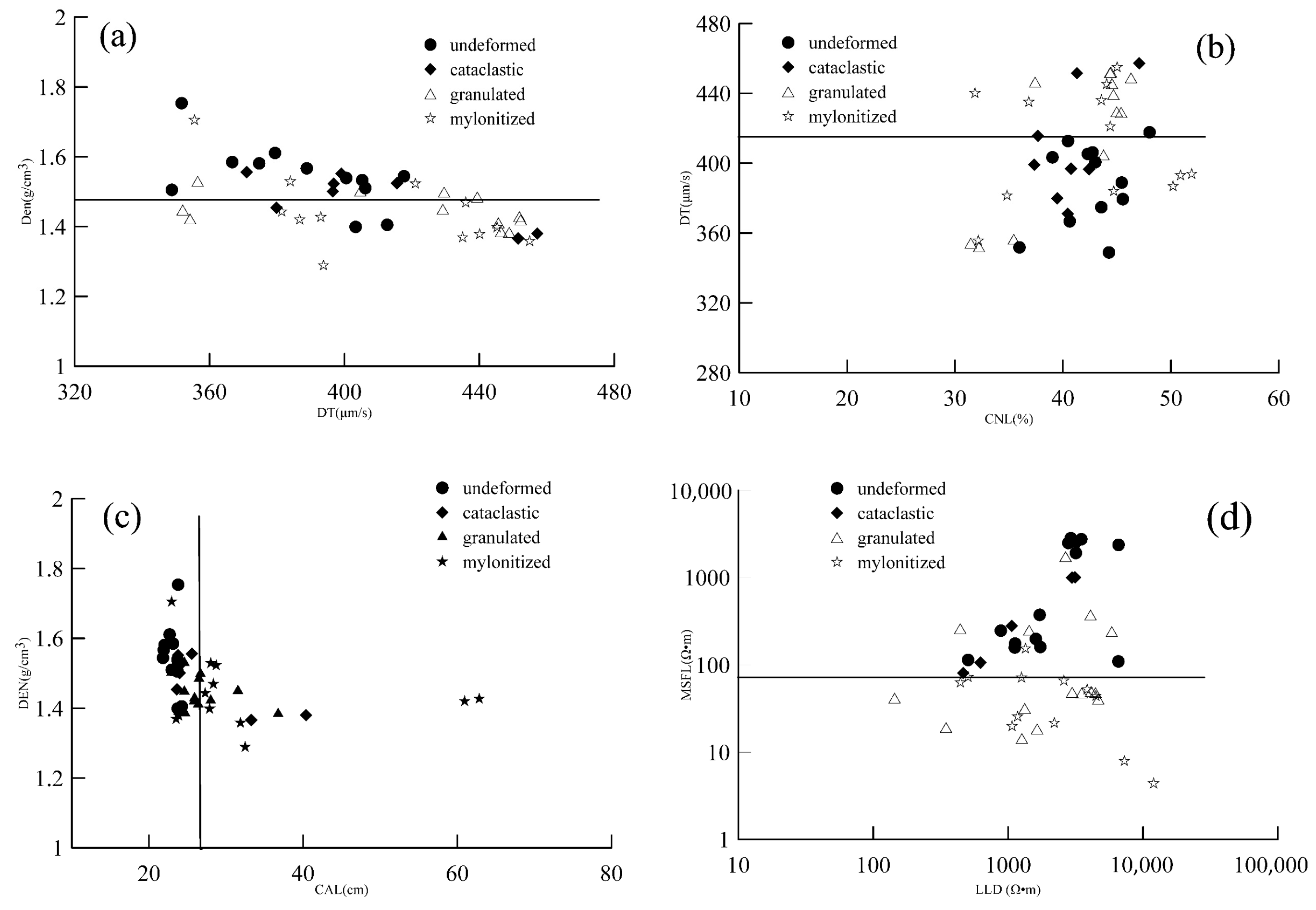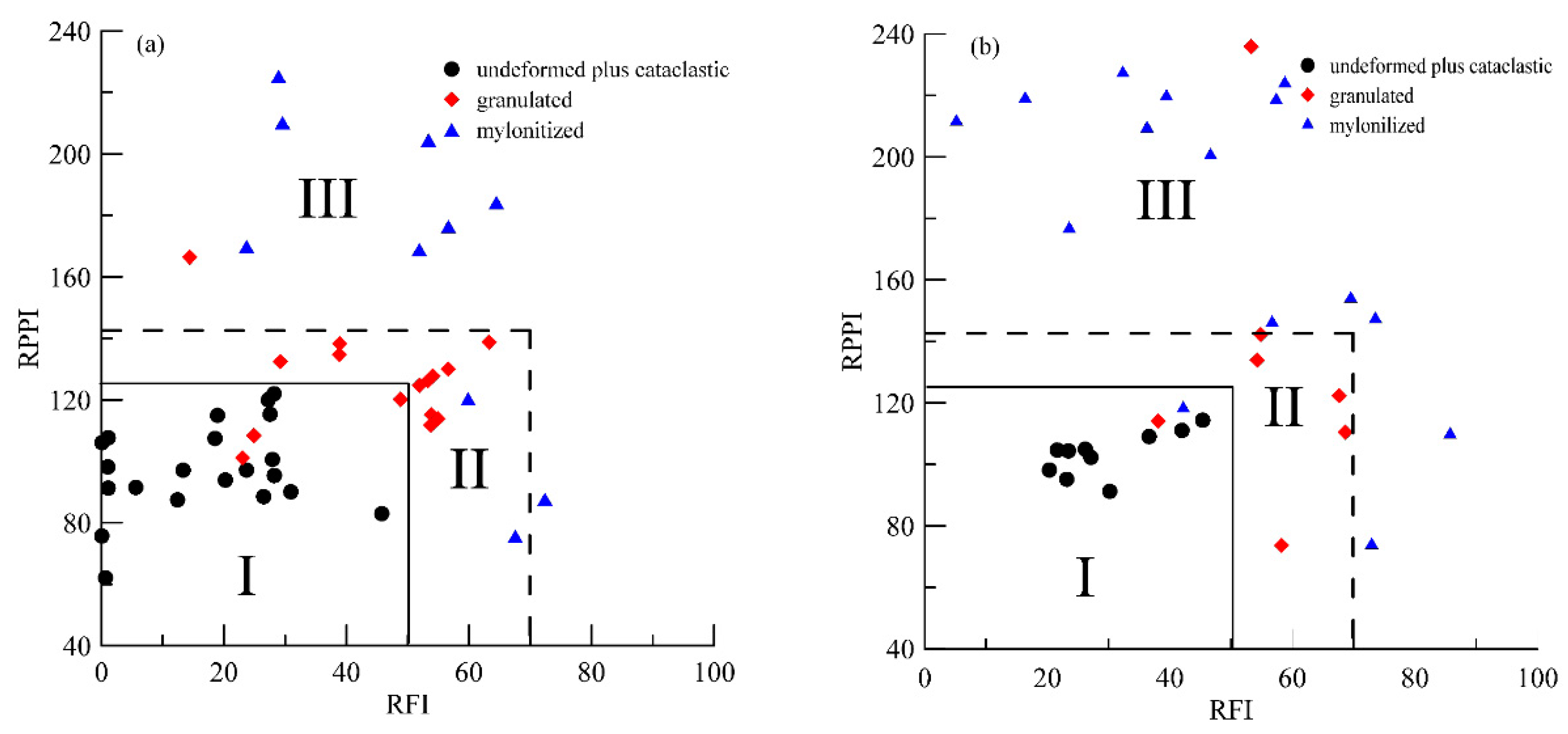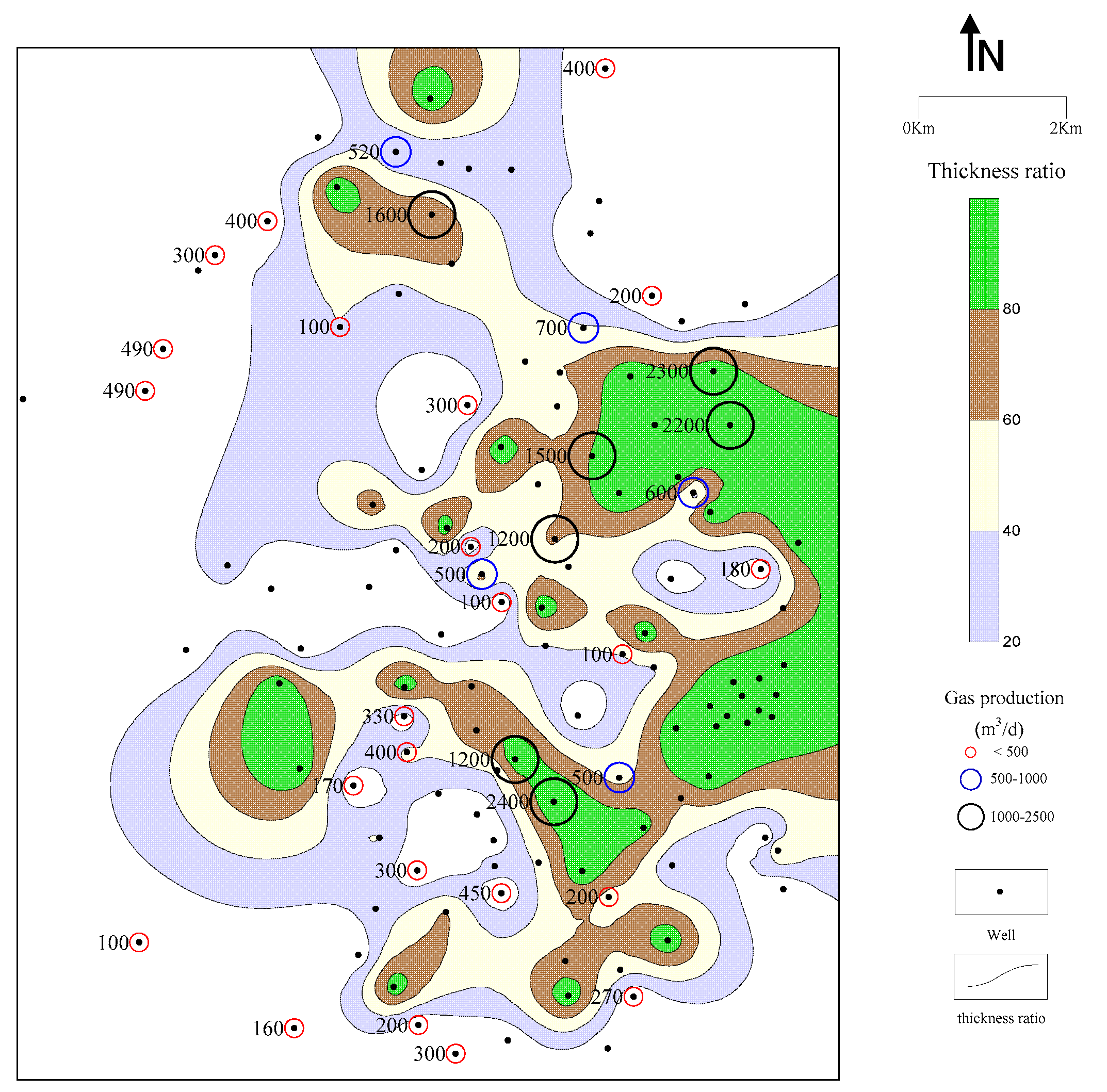Productivity Evaluation of Coalbed Methane Well with Geophysical Logging-Derived Tectonically Deformed Coal
Abstract
:1. Introduction
2. Geological Setting
2.1. Geological Setting
2.2. Coal-Bearing Strata
2.3. Site Observations of Coal Samples
3. Method
3.1. Depth Matching of Coal Samples and Geophysical Logging Data
3.2. Logging Data Processing Methods
3.2.1. Logging Data Normalization
3.2.2. Optimization of Well-Logging Data
3.3. Relative Physical Properties Indicator (RPPI)
3.4. Relative Fluid Indicator (RFI)
4. Results
5. Discussion
5.1. Identification of TDC with a Static RPPI and Dynamic RFI
5.2. TDC and CBM Well Productivity
6. Conclusions
7. Patent
Author Contributions
Funding
Conflicts of Interest
References
- Hou, Q.; Li, H.; Fan, J.; Ju, Y.; Wang, T.; Li, X.; Wu, Y. Structure and coalbed methane occurrence in tectonically deformed coals. Sci. China Earth Sci. 2012, 55, 1755–1763. [Google Scholar] [CrossRef]
- Clarkson, C.R. Production data analysis of unconventional gas wells: A review of theory and best practices. Int. J. Coal Geol. 2013, 109, 101–146. [Google Scholar] [CrossRef]
- Connell, L.D.; Lu, M.; Pan, Z.J. An analytical coal permeability model for tri-axial strain and stress conditions. Int. J. Coal Geol. 2010, 84, 103–114. [Google Scholar] [CrossRef]
- Fu, X.; Qin, Y.; Wang, G. Evaluation of coal structure and permeability with the aid of geophysical logging technology. Fuel 2009, 88, 2278–2285. [Google Scholar] [CrossRef]
- Fu, X.; Jiang, B.; Qin, Y. Identifying coal structure and forecast of coal reservoir permeability using well logs. J. Well Log. Tech. 2003, 27, 140–143. [Google Scholar]
- Pan, Z.; Connell, L.D. Modelling of anisotropic coal swelling and its impact on permeability behaviour for primary and enhanced coalbed methane recovery. Int. J. Coal Geol. 2011, 85, 257–267. [Google Scholar] [CrossRef]
- Yao, Z.; Cao, D.; Wei, Y.; Li, X.; Wang, X.; Zhang, X. Experimental analysis on the effect of tectonically deformed coal types on fines generation characteristics. J. Petrol. Sci. Eng. 2016, 146, 350–359. [Google Scholar] [CrossRef]
- Li, Y.; Wang, L.; Liu, G. Study on coal reservoir damage mechanism in dewatering and extraction process of CBM wells. China Coal. Meth. 2010, 7, 39–43. [Google Scholar]
- China National Standard. Classification of Coal-Body Structure (GB/T 30050-2013); China National Standardization Administration: Beijing, China, 2013. [Google Scholar]
- Zhao, H.; Zhang, H.; Yin, G. Experiments on triaxial mechanical properties of soft coal containing gas. J. Chongqing Univ. 2013, 36, 103–109. [Google Scholar]
- Wang, Y.; Xu, X.; Yang, D. Ultrasonic elastic characteristics of five kinds of metamorphic deformed coals under room temperature and pressure conditions. Sci. China Earth Sci. 2014, 11, 2431–2439. [Google Scholar] [CrossRef]
- Wang, Y.; Xu, X.; Zhang, Y. Ultrasonic elastic characteristics of six kinds of metamorphic coals in China under room temperature and pressure conditions. Chin. J. Geophys. 2016, 59, 350–363. [Google Scholar]
- Teng, J. Identification of Coal Structures with the Aid of Geophysical Logs: A Case Study of the Southern Qinshui Basin. Ph.D. Thesis, China University of Geosciences, Beijing, China, 2016. [Google Scholar]
- Lv, S.; He, J. Electrical property measurements for the outburst coal mass. J. Cent. Sout. Univ. Tech. 1998, 29, 511–513. [Google Scholar]
- Chen, H.; Jiang, B.; Chen, T.; Xu, S.; Zhu, G. Experimental study on ultrasonic velocity and anisotropy of tectonically deformed coal. Int. J. Coal Geol. 2017, 179, 242–252. [Google Scholar] [CrossRef]
- Song, X.; Tang, Y.; Li, W.; Zeng, H.; Xiang, J. Pore structure in tectonically deformed coals by small angle X-ray scattering. J. China Coal Society. 2014, 39, 719–724. [Google Scholar]
- Lu, J.; Wang, Y.; Chen, J. Detection of tectonically deformed coal using model-based joint inversion of multi-component seismic data. Energies 2018, 11, 829–845. [Google Scholar] [CrossRef]
- Hou, H.; Shao, L.; Guo, S.; Li, Z.; Zhang, Z.; Yao, M. Evaluation and genetic analysis of coal structures in deep Jiaozuo Coalfield, northern China: Investigation by geophysical logging data. Fuel 2017, 209, 552–566. [Google Scholar] [CrossRef]
- Fu, X.; Lu, G. The effect of logs in predicting coal and gas outburst. Coal Geol. China 1998, 10, 82–83. [Google Scholar]
- Qiao, W.; Ni, X.; Zhang, X. The relation between the coal structure combination and the changes in well diameter. J. Henan Polyt. Univ. 2010, 29, 162–166. [Google Scholar]
- Chen, Y.; Tang, D.; Xu, H. The distribution of coal structure in Hancheng based on well logging data. J. China Coal Soci. 2013, 38, 1435–1442. [Google Scholar]
- Lu, X.; Huang, W.; Wang, J. The development characteristics of deep coal structure in northern Shizhuang area. Coal Geol. Expl. 2014, 42, 8–11. [Google Scholar]
- Guo, T.; Wang, Y. Evaluation of logging of coal texture of seam 2 in southern of Yanchuan and analysis of its main controlling factors. Coal Geol. Expl. 2014, 42, 22–25. [Google Scholar]
- Li, J.; Liu, D.; Yao, Y. Evaluation of the reservoir permeability of anthracite coals by geophysical logging data. Int. J. Coal Geol. 2011, 87, 121–127. [Google Scholar] [CrossRef]
- Liu, J.; Wang, J.; Fu, Q. Study on logging response characteristics and distribution of coal rock structure in Zhengzhuang Area. J. Coal Sci. Eng. 2013, 10, 9–14. [Google Scholar]
- Ma, G.; Chen, T.; Cui, R. Identification of tectonically deformed coal using well logs: A case study. Prog. Geophy. 2017, 32, 1208–1216. [Google Scholar]
- Yao, J.; Sima, L.; Zhang, Y. Quantitative identification of deformed coals by geophysical logging. J. China Coal Soc. 2011, 36, 94–98. [Google Scholar]
- Wang, Y.; Liu, D.; Cai, Y.; Yao, Y.; Zhou, Y. Evaluation of structured coal evolution and distribution by geophysical logging methods in the Gujiao block, northwest Qinshui basin, China. J. Nat. Gas Sci. Eng. 2018, 51, 210–222. [Google Scholar] [CrossRef]
- Tang, S.; Tang, D.; Li, S.; Xu, H.; Tao, S.; Geng, Y. Fracture system identification of coal reservoir and the productivity differences of CBM wells with different coal structures: A case in the Yanchuannan Block, Ordos basin. J. Petrol. Sci. Eng. 2018, 161, 175–189. [Google Scholar] [CrossRef]
- Wang, X.; Li, Y.; Chen, T. Quantitative thickness prediction of tectonically deformed coal using extreme learning machine and principal component analysis: A case study. Comput. Geosci. 2017, 101, 38–47. [Google Scholar] [CrossRef]
- Xie, X.; Fan, M. Quantitative identification of deformed coals based on logging response. China Coal. Meth. 2013, 10, 27–29. [Google Scholar]
- Sibbit, A.M.; Faivre, O. The dual laterolog response in fractured rock. In Proceedings of the SPWLA 26th Annual Logging Symposium, Dallas, TX, USA, 17–20 June 1985. [Google Scholar]
- Hoyer, D.L. Evaluation of coalbed fracture porosity from dual laterolog Log. Log Anal. 1991, 32, 654–662. [Google Scholar]
- Rozak, A.T. Evaluation and Application of Fracture Detection Software to Coalbed Methane Exploration. Ph.D. Thesis, University of British Columbia, Kelowna, BC, Canada, 2003. [Google Scholar]
- Rozak, A.T.; Bustin, R.M.; Strashok, G.W.; Beaton, A.; Richardson, R.; Hunter, T. Application of logfac to coalbed methane exploration in western Canada: A case history from Ardley coals near Red Deer Alberta. In Proceedings of the SPE Gas Technology Symposium, Calgary, AB, Canada, 30 April–2 May 2002. [Google Scholar]
- Chen, Q.; Yao, H.; Chang, S. Coalbody structure classification method based on dual-lateral and RXO cross-plot analysis. J. Coal Sci. Eng. 2013, 19, 522–529. [Google Scholar] [CrossRef]
- Chen, G.; Hu, Z.; Su, K.; Zhang, Y. Analysis on relationship between coal structure and gas production quantity in deep coal seam of Yanchuannan area at southeast Ordos. Coal Sci. Tech. 2016, 44, 107–112. [Google Scholar]
- Wang, L.; Liu, C.; Wu, Y. Shanxi Formation coal No.2 lithotype features and gas-bearing property logging response analysis in Yanchuan South Block. China Coal Geol. 2013, 25, 48–52. [Google Scholar]
- Li, Z.; Han, M.; Wei, J.; Yu, J.; Li, J.; Lu, D. Analysis of high-resolution sequence stratigraphy and coal accumulation law of upper Paleozoic erathem in Ordos basin. J. China Univ. Petro. Nat. Sci. 2008, 32, 5–12. [Google Scholar]
- China Energy Industry Standard of Quality. The Specifications for Coalbed Methane Well-Logging (NB/T 10021-2015); China National Energy Administration: Beijing, China, 2015. [Google Scholar]
- China Energy Industry Standard of Quality. Acceptance Specification for Coalbed Methane Well-Logging Data and Its Interpretation Data (NB/T 10023-2015); China National Energy Administration: Beijing, China, 2015. [Google Scholar]
- Wei, J.; Chen, Y.; Wen, J. Study of gas desorption laws of tectonically Coal. Safe. Coal Mines 1998, 29, 1–3. [Google Scholar]
- Hu, G.; Jiang, B.; Chen, F. Study on different type structure coal features and gas outburst control. Coal Sci. Tech. 2012, 40, 111–115. [Google Scholar]
- Levine, J.R. Model Study of the influence of matrix shrinkage on absolute permeability of coalbed reservoirs. Geol. Soci. Publ. 1996, 199, 197–212. [Google Scholar] [CrossRef]
- Harpalani, S.; Schraufnagel, R.A. Shrinkage of coal matrix with the release of gas and its impact on the permeability of coal. Fuel 1990, 69, 551–556. [Google Scholar] [CrossRef]
- Chen, J.; Zhang, S.; Huang, Z. Coupling effect between coal matrix shrinkage and its mechanical properties. J. Wuhan Univ. Tech. 2004, 26, 67–70. [Google Scholar]
- Ren, P.; Xu, H.; Tang, D.; Li, Y.; Sun, C.; Tao, S.; Li, S.; Xin, F.; Gao, L. The identification of coal texture in different rank coal reservoirs by using geophysical logging data in northwest Guizhou, China: Investigation by principal component analysis. Fuel 2018, 230, 258–265. [Google Scholar] [CrossRef]











| Type of Structure | Coal Core Shape | Macroscopic Fracture Characteristics |
|---|---|---|
| undeformed | bulk, columnar | Endogenous cracks are developed, with the density of the face cleat 4~6/5 cm and the butt cleat 8~10/5 cm |
| cataclastic | short, columnar | Exogenous cracks are developed, with the density of the face cleat 14~16/5 cm and the butt cleat 16~18/5 cm |
| granulated | clastic, granular | Conchoidal fractures are developed |
| mylonitized | granular, powdery | No cleats or cracks are found |
| Pearson Correlation | CAL | LLD | LLS | MSFL | DT | DEN | CNL | |
|---|---|---|---|---|---|---|---|---|
| Correlation coefficient | CAL | 1.00 | −0.16 | −0.14 | −0.21 | 0.06 | −0.28 | 0.29 |
| LLD | −0.16 | 1.00 | 0.96 * | 0.11 | 0.03 | 0.11 | −0.26 | |
| LLS | −0.14 | 0.96 * | 1.00 | 0.07 | 0.07 | 0.08 | −0.19 | |
| MSFL | −0.21 | 0.11 | 0.07 | 1.00 | −0.17 | 0.31 | −0.34 | |
| DT | 0.06 | 0.03 | 0.07 | −0.17 | 1.00 | −0.31 | 0.40 * | |
| DEN | −0.28 | 0.11 | 0.08 | 0.31 | −0.31 | 1.00 | −0.75 * | |
| CNL | 0.29 | −0.26 | −0.19 | −0.34 | 0.40 * | −0.75 * | 1.00 | |
| Significance (1-tailed) | CAL | - | 0.15 | 0.19 | 0.09 | 0.36 | 0.03 | 0.03 |
| LLD | 0.15 | - | 0.00 * | 0.24 | 0.41 | 0.24 | 0.05 | |
| LLS | 0.19 | 0.00 * | - | 0.34 | 0.34 | 0.31 | 0.11 | |
| MSFL | 0.09 | 0.24 | 0.34 | - | 0.14 | 0.02 | 0.01 * | |
| DT | 0.36 | 0.41 | 0.34 | 0.14 | - | 0.02 | 0.00 * | |
| DEN | 0.03 | 0.24 | 0.31 | 0.02 | 0.02 | - | 0.00 * | |
| CNL | 0.03 | 0.05 | 0.11 | 0.01 * | 0.00 * | 0.00 * | - | |
| Component | Initial Eigenvalues | Rotation Sums of Squared Loadings | ||||
|---|---|---|---|---|---|---|
| Total | % of Variance | Cumulative % | Total | % of Variance | Cumulative % | |
| 1 | 1.74 | 34.83 | 34.83 | 1.00 | 20.06 | 20.06 |
| 2 | 1.09 | 21.74 | 56.57 | 1.00 | 20.04 | 40.10 |
| 3 | 0.82 | 16.32 | 72.89 | 1.00 | 20.03 | 60.13 |
| 4 | 0.76 | 15.23 | 88.12 | 1.00 | 20.02 | 80.15 |
| 5 | 0.59 | 11.88 | 100.00 | 0.99 | 19.85 | 100.00 |
| Coal Samples | TDC Observed | Gas Content (m3/t) | CAL (cm) | LLD (Ω·m) | MSFL (Ω·m) | DEN (g/cm3) | DT (us/m) | RPPI | RFI | TDC Interpreted |
|---|---|---|---|---|---|---|---|---|---|---|
| L1-2 | undeformed | 9.33 | 23.7 | 2244.8 | 2364.8 | 1.8 | 351.7 | 62.1 | 0.7 | Type I |
| L1-12 | undeformed | 10.69 | 22.6 | 2509.7 | 2494.0 | 1.6 | 366.7 | 75.7 | 0.1 | Type I |
| C03-11-10 | undeformed | 15.64 | 22.1 | 5762.7 | 109.5 | 1.6 | 400.5 | 82.9 | 45.8 | Type I |
| C03-11-12 | undeformed | 19.68 | 21.8 | 1553.5 | 160.1 | 1.5 | 429.3 | 90.0 | 30.9 | Type I |
| C04-11-06 | undeformed | 11.10 | 22.8 | 494.3 | 113.8 | 1.5 | 392.6 | 97.2 | 23.7 | Type I |
| L1-1 | undeformed | 8.79 | 23.6 | 2730.4 | 2750.5 | 1.4 | 409.6 | 106.0 | 0.1 | Type I |
| C04-11-08 | undeformed | 14.11 | 23.7 | 865.3 | 246.8 | 1.4 | 362.0 | 107.4 | 18.6 | Type I |
| C04-11-05 | undeformed | 15.98 | 23.0 | 1578.1 | 198.3 | 1.3 | 417.9 | 121.9 | 28.2 | Type I |
| L1-6 | undeformed | 13.56 | 23.8 | 3001.0 | 1912.4 | 1.5 | 400.5 | 91.5 | 5.6 | Type I |
| L1-11 | undeformed | 12.18 | 23.1 | 2584.5 | 2823.8 | 1.5 | 405.3 | 91.3 | 1.1 | Type I |
| C08-11-01 | undeformed | 14.90 | 24.0 | 1123.2 | 157.9 | 1.6 | 448.5 | 100.6 | 27.9 | Type I |
| C08-11-03 | undeformed | 16.00 | 23.6 | 1129.9 | 175.7 | 1.6 | 420.4 | 88.5 | 26.5 | Type I |
| L1-13 | undeformed | 15.88 | 21.8 | 1900.8 | 1746.3 | 1.4 | 405.8 | 107.6 | 1.1 | Type I |
| S12-1 | undeformed | 11.34 | 23.6 | 3541.2 | 373.2 | 1.4 | 414.3 | 115.3 | 27.5 | Type I |
| L1-10 | cataclastic | 12.58 | 25.2 | 2663.3 | 1000.1 | 1.6 | 371.0 | 87.4 | 12.4 | Type I |
| L1-8 | cataclastic | 16.35 | 23.7 | 2922.5 | 1008.0 | 1.5 | 415.6 | 97.1 | 13.3 | Type I |
| L1-7 | cataclastic | 10.98 | 23.8 | 2646.0 | 2432.2 | 1.5 | 379.9 | 98.1 | 1.1 | Type I |
| C04-11-04 | cataclastic | 12.89 | 23.6 | 1045.0 | 280.0 | 1.4 | 412.3 | 114.9 | 18.9 | Type I |
| C04-11-03 | cataclastic | 12.20 | 23.8 | 611.9 | 106.4 | 1.4 | 410.0 | 120.0 | 27.3 | Type I |
| C04-11-01 | cataclastic | 13.11 | 23.7 | 455.3 | 80.8 | 1.5 | 396.6 | 95.4 | 28.2 | Type I |
| C04-11-02 | cataclastic | 13.91 | 23.1 | 1681.0 | 374.4 | 1.5 | 406.2 | 93.9 | 20.2 | Type I |
| C06-11-02 | granulated | 14.51 | 27.1 | 1307.5 | 250.2 | 1.5 | 344.9 | 101.2 | 23.0 | Type I * |
| C08-11-02 | granulated | 15.53 | 24.0 | 143.5 | 41.7 | 1.5 | 464.0 | 108.4 | 24.9 | Type I * |
| C01-11-10 | granulated | 18.53 | 25.8 | 4478.8 | 48.7 | 1.5 | 426.9 | 111.8 | 53.8 | Type II |
| C01-11-09 | granulated | 14.68 | 25.7 | 4357.8 | 47.7 | 1.5 | 436.8 | 115.2 | 53.9 | Type II |
| C02-11-04 | granulated | 17.60 | 24.7 | 322.0 | 19.2 | 1.3 | 383.8 | 120.1 | 48.8 | Type I * |
| C01-11-08 | granulated | 16.95 | 25.2 | 4319.0 | 49.9 | 1.4 | 449.3 | 126.2 | 53.3 | Type II |
| C01-11-07 | granulated | 15.56 | 25.1 | 4650.5 | 48.2 | 1.4 | 449.6 | 127.8 | 54.1 | Type II |
| C01-11-06 | granulated | 12.41 | 25.6 | 5079.9 | 40.6 | 1.4 | 443.0 | 130.0 | 56.6 | Type II |
| C02-11-06 | granulated | 19.20 | 26.3 | 7830.4 | 240.4 | 1.3 | 385.9 | 134.7 | 38.9 | Type II |
| C01-11-11 | granulated | 15.32 | 30.0 | 2850.1 | 18.5 | 1.5 | 426.5 | 138.8 | 63.3 | Type II |
| S10 | granulated | 14.82 | 24.8 | 121.5 | 60.7 | 1.2 | 431.7 | 166.4 | 14.4 | Type III * |
| C01-11-03 | granulated | 11.06 | 27.3 | 3777.7 | 52.4 | 1.5 | 433.4 | 124.7 | 51.9 | Type II |
| C01-11-02 | granulated | 13.97 | 26.9 | 1081.3 | 71.4 | 1.4 | 442.6 | 138.3 | 38.9 | Type II |
| C06-11-03 | granulated | 13.95 | 29.5 | 1228.6 | 153.8 | 1.4 | 369.8 | 132.4 | 29.2 | Type II |
| C01-11-04 | granulated | 14.09 | 27.6 | 4401.9 | 43.9 | 1.5 | 418.4 | 113.9 | 54.9 | Type II |
| C01-11-12 | mylonitized | 16.06 | 34.5 | 1810.0 | 14.4 | 1.4 | 446.2 | 184.2 | 64.5 | Type III |
| C01-11-13 | mylonitized | 16.76 | 37.6 | 1668.8 | 31.8 | 1.4 | 454.6 | 204.5 | 53.4 | Type III |
| S12-2 | mylonitized | 14.20 | 23.8 | 2111.1 | 21.6 | 1.4 | 410.2 | 120.3 | 59.9 | Type II * |
| S11 | mylonitized | 16.53 | 33.2 | 241.9 | 65.8 | 1.4 | 409.5 | 169.8 | 23.7 | Type III |
| C05-11-01 | mylonitized | 16.61 | 54.8 | 357.4 | 62.8 | 1.4 | 306.3 | 210.1 | 29.6 | Type III |
| C05-11-02 | mylonitized | 20.44 | 57.6 | 415.2 | 72.6 | 1.4 | 312.6 | 225.1 | 28.9 | Type III |
| C06-11-01 | mylonitized | 15.71 | 33.6 | 980.0 | 19.8 | 1.3 | 401.0 | 176.3 | 56.6 | Type III |
| C07-11-01 | mylonitized | 14.83 | 23.9 | 7288.0 | 17.9 | 1.7 | 391.3 | 75.7 | 67.6 | Type II * |
| C07-11-03 | mylonitized | 15.43 | 27.4 | 15567.6 | 14.4 | 1.7 | 405.1 | 87.6 | 72.4 | Type III |
| C01-11-01 | mylonitized | 14.04 | 30.3 | 841.8 | 25.5 | 1.4 | 452.3 | 168.8 | 51.9 | Type III |
| Coal Seam | TDC | Interpretation Parameters | Identification Result | Misjudgment Number | Total Number | Misjudgment Rate |
|---|---|---|---|---|---|---|
| No. 11 | Undeformed plus cataclastic | RPPI < 125 and RFI < 50 | Type I | 3 | 24 | 12.5% |
| granulated | 125 < RPPI < 142 and 50 < RFI < 70 | Type II | 2 | 13 | 15.4% | |
| mylonitized | RPPI > 142 or RFI > 70 | Type III | 1 | 9 | 11.1% | |
| No. 5 | Undeformed plus cataclastic | RPPI < 125 and RFI < 50 | Type I | 2 | 15 | 13.3% |
| granulated | 125 < RPPI < 142 and 50 < RFI < 70 | Type II | 0 | 5 | 0% | |
| mylonitized | RPPI > 142 or RFI > 70 | Type III | 1 | 15 | 6.7% | |
| Total | - | - | - | 9 | 81 | 11.1% |
© 2019 by the authors. Licensee MDPI, Basel, Switzerland. This article is an open access article distributed under the terms and conditions of the Creative Commons Attribution (CC BY) license (http://creativecommons.org/licenses/by/4.0/).
Share and Cite
Chen, Q.; Jing, J.; Liu, J.; Long, J.; Zhang, S. Productivity Evaluation of Coalbed Methane Well with Geophysical Logging-Derived Tectonically Deformed Coal. Energies 2019, 12, 3459. https://doi.org/10.3390/en12183459
Chen Q, Jing J, Liu J, Long J, Zhang S. Productivity Evaluation of Coalbed Methane Well with Geophysical Logging-Derived Tectonically Deformed Coal. Energies. 2019; 12(18):3459. https://doi.org/10.3390/en12183459
Chicago/Turabian StyleChen, Qiang, Jin Jing, Jun Liu, Jianhui Long, and Sheng Zhang. 2019. "Productivity Evaluation of Coalbed Methane Well with Geophysical Logging-Derived Tectonically Deformed Coal" Energies 12, no. 18: 3459. https://doi.org/10.3390/en12183459






